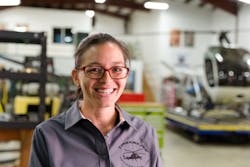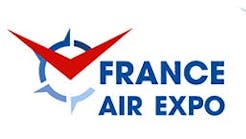Documentary Highlights How the Aviation Industry is Working Together to Create an Adaptable Workforce Pipeline
Jennifer Treman’s moment of triumph is on a flyer hanging in her house in Sandpoint, Idaho. It contains a photo of her overjoyed reaction to starting a Cessna airplane.
“That was my first time doing that. It’s like a war cry shot of my excitement,” Treman said.
Coming from a background where she had zero mechanical experience to being on the North Idaho College Aerospace Center of Excellence brochure, Treman, the mother of two boys, had to take a chance on a new direction for her and her family.
Through NIC’s Aviation Maintenance Technology program at its state-of-the-art facility in Hayden, Idaho, she was able to pursue and realize her dream of working with aircraft. Yet without the intervention of industry leaders in this remote corner of the state, Treman may have never had the opportunity to capitalize on her passion for aviation.
Her story illustrates how the NIC Aerospace Center of Excellence continues its work in developing a new generation of in-demand workers while keeping an eye on the future of aviation maintenance and advanced manufacturing.
Up in the Air
Treman still has a little trouble adjusting to her morning routine. She starts her day at 3:30 a.m., gets in some yoga and gets ready for the day before she heads over to Timberline Helicopters in Sandpoint for a 10-hour workday.
“I definitely look forward to coming to work,” said Treman. “Waking up early is not the fun part, but after I’m here I enjoy it. I look forward to what I’m going to be doing that day.”
As a shop technician at Timberline, she has an opportunity to repair and maintain its fleet of helicopters, ranging from the famous UH-60A “Black Hawk” helicopter to the workhorse of the Vietnam War, a Bell H1 Huey. These helicopters are used for a range of jobs from heavy lifting, to power line construction and firefighting operations in the U.S. and Australia.
One of her supervisors, Travis Storro, COO of Timberline, recalled when he knew he made the right hire in Treman. It was when he got a call from a Federal Aviation Administration inspector.
“He called me up and he said, ‘Wow, you guys really scored hiring Jennifer,’” Storro said. “And I said to him, ‘What are you talking about?’ He said, ‘Yeah, I was doing surveillance on the mechanic examinations and I’ve never seen anyone do so well on their airframe test. I just had to call you and tell you.’”
Treman said that her teachers at NIC, ACE Director Patrick “Pat” O’Halloran and instructor Earl Thomas gave her the dedicated guidance and held her to the rigorous standards upon which she built her foundation for aircraft maintenance. The hands-on work at ACE was easy enough for her – she liked getting into the grease and wrench-turning – but preparing for the FAA airframe exam required a serious dedication, one which earned her praise from the FAA inspector.
“The studying was intense. I studied a lot, because my brain can’t retain information well unless I write it down on flashcards. I must have had a stack of 500 flashcards to help me study for tests, quizzes, and the FAA exams itself,” Treman said.
Originally from Hermosa Beach, California, Treman relocated to Idaho with her husband Cory. Once seeing the abundant Rocky Mountain beauty of the Idaho Panhandle region, she saw that her future was in the clouds.
“After moving up here and seeing how beautiful this place is I wanted to always be up in the air and enjoy it from that perspective,” Treman said.
Treman worked for five years in a machine shop but felt that the job did not offer a way for her to advance her career. One of her former co-workers shared information which detailed a future in aircraft maintenance. That is what prompted her to go back to school to change her life. It was a tough decision and one that her husband understood what kind of sacrifices the family would have to make to achieve her dream.
“Knowing how happy it was going to make her, it was totally worth it. I knew that it was going to be a struggle for a year or so. There was going to be a lot put on my plate. But for her to get up and be happy on a day-to-day basis? Totally worth it,” Cory Treman said.
Before she became a member of the first cohort of NIC aviation maintenance students in the 2015 Fall semester, O’Halloran said that she was “chomping at the bit” and calling him before the FAA-approved program launched.
“Jennifer was a best-case scenario student, especially for a new program starting up like ours. We couldn’t have done better than to have her,” O’Halloran said. “She even came down and started knocking out general-ed English and math and the requirements for an [associate’s] degree.
Much like many parents who decide to go back to school, Treman had to sacrifice quality time with her family so she could honor the aviation center’s mandatory attendance policy. Treman would make the 45-minute drive from Sandpoint to the NIC aviation center Monday through Thursdays, worked a part-time job and helped Cory around the house with her sons JC and Jack.
After being laid off from her job, her family went down to just Cory’s income and had to make ends meet with some assistance from their families. But she realized that obtaining her FAA airframe license would make her a prime candidate for a job in the growing aviation industry and net her a good salary.
“I knew that having the license will get me one step further into a door of a company like [Timberline]. With somebody like me who had absolutely no mechanical experience at all, having this license was going to get my foot in the door,” Treman said.
Treman said she hopes that her story will inspire more students to choose a career pathway in the aviation industry. To ensure that this industry thrives in this remote corner of the U.S., its leaders and educators had to organize to attract more students like her.
A Workforce In Demand
In the Pacific Northwest, Washington gets the headlines as a leader in the aviation industry as a home to Boeing and many subsidiary manufacturing businesses. However, Idaho once held its own as an aerospace workforce creator back in World War II.
NIC supported the war effort, according to O’Halloran, until its training programs shifted away from aviation and into automobiles in the 1950’s and 1960’s. It still had its aviation manufacturing program, but without modernization, the program was not keeping up with the rapid change in manufacturing technology.
The aviation maintenance program was dormant until local aerospace industry leaders were confronted with an impending labor shortage. O’Halloran said that industry growth is outpacing the region’s ability to replace retiring workers, echoing a trend happening nationwide across many industries.
“The manufacturers have unprecedented demand for their products. Look at Boeing and the 737 MAX. Those new aircraft are selling years in advance. They know what they’ll be building for the next five or six years. Someone’s going to have to fix and maintain and fly those aircraft. There’s a huge need,” O’Halloran said.
Despite the damaging effects of the Great Recession of 2008 on the labor market, aerospace employment was resilient. Demand for aviation mechanics and technicians is expected to grow by 5 percent through 2026, according to the Bureau of Labor Statistics. This is in line with Boeing’s long-term projection of 2.6 percent projected long-term growth in airline traffic in North America.
To respond to this demand, companies like Priest River-based Aerocet, which makes composite floats for light aircraft, joined forces with other manufacturers and suppliers to form the Idaho Aerospace Alliance. Its mission is to maintain a cooperative alliance between manufacturers and educators to create an adaptable workforce pipeline.
Aerocet is a leader in manufacturing composite floats for aircraft. Photo – Aerocet website
Though Idaho has fewer than 600 employed mechanics and technicians, replacing this valuable workforce, especially in this remote sector of the state, was made tougher by the lack of local educational opportunities. O’Halloran said that before the maintenance program’s inception, students would have to train across the state border in Washington or stay in-state with the nearest program in Pocatello, which is 10 hours away from Hayden.
The IAA went into action and got the attention of the Idaho Department of Labor, and a grant for the NIC program was submitted to the U.S. Department of Labor. In 2013, NIC was provided a $3 million federal grant to revive the maintenance program and bolster the capabilities of its manufacturing program.
“We’ve got a burgeoning industry, and more so even more in our area, and so it’s the right thing for a community college to do: Rise to the occasion,” O’Halloran said.
With the federal funding, NIC and O’Halloran forged partnerships with the IAA and its member organizations to create an adaptable curriculum where every semester matters.
“We’d show what we thought was the right curriculum. They’d give us some advice and feedback from aircraft maintenance and companies nearby: Empire Aerospace, Timberline Helicopter, there’s a whole litany. We have Unitech Composites, we have Aerocet in this area. It really was taking off as a niche, and they’ve stayed in the conversation, they’ve hired our graduates,” O’Halloran said.
The two disciplines offered at ACE, aviation maintenance and aerospace advanced manufacturing, offer a mix of online courses and hands-on work during ACE’s lab hours. The maintenance program prepares students for two FAA exams in General Aviation and Airframe maintenance.
On the other side, NIC students can opt for the two-year manufacturing program and work in airframe maintenance, CNC machining and composite repair and manufacturing to obtain an associate’s degree. NIC also offers a flexible schedule which is adapted to the changing needs of students.
According to O’Halloran, a student who completes the first semester of composite repair and manufacturing can walk away from the program with a certification and have an advantage for an entry-level position in manufacturing. “Life happens,” he said and NIC can provide an education that can get results, even without obtaining an associate’s degree.
Up, Up and Away
Treman was one of those fortunate students who was snapped up by Timberline during the course of her FAA examinations. Though the bulk of her studies involved airplanes, she would have the skills to work at Timberline.
“In the Aviation Maintenance Technology Program, I was taught to fix aircraft. Everything that’s involved, besides the engines, and most of it was on airplanes. Very little was about helicopters,” Treman said.
Within one year of starting the program, she was now earning a paycheck. She said that NIC changed her life because she went from zero experience in working with aircraft to having a foundation for a career in maintenance and beyond.
She said that her co-workers at Timberline have treated her like a family and have trained her to learn a new discipline in helicopter repair. Treman said that she felt at home in her new career after about a month on the job.
“The whole company has been patient with me. I’m green. They encourage me to better myself and they give me time because I pick up things quickly,” Treman said.
Storro said that NIC provided Timberline a great employee in Treman because of her ability to adapt to any situation. He said that Timberline has brought in another graduate of the program from her recommendation.
“Having somebody come in and know how to access information, how to apply information, the basics of how to approach tasks on an aircraft, and the important safety aspects of working on aircraft are very important. And having that firm foundation when they start is definitely beneficial to any employer,” Storro said.
As for the future, Treman said that she is content with the wrench-turning and repair for now. She said that she is striving to be the best mechanic she can be. Her instructor at NIC, Earl Turner said he believes she has a bright career ahead of her.
“Jennifer is going to be one of the first to attain to an inspection authorization in her maintenance training field. It’s like a journeyman’s license but in aircraft. It’s an authorized inspection license, and I think she’s well on her way to that, easily can fulfill that duty,” Turner said.
Treman said that she made the right decision by choosing North Idaho College’s Aerospace Center of Excellence and thinks her story can inspire others to start a new career path.
“To know how proud my family is of what I’ve accomplished makes it that much more worth it to get to where I am now and to continue to succeed,” Treman said. “I want to be the best aircraft mechanic there is. I want to be the best role model to my kids, to everybody else, guys and girls out there. It’s never too late to start.”
For more on the North Idaho College Aerospace Center of Excellence, visit their website or watch NIC’s introductory video to the Aviation Maintenance Technology program.
Join the Conversation: Give us your reactions to our latest Do Something Awesome mini-documentary on our Facebook page.
Through our Do Something Awesome series, WorkingNation is committed to telling powerful stories of programs across the nation which prepare Americans for the future of work. Check out our previous mini-documentaries here.




